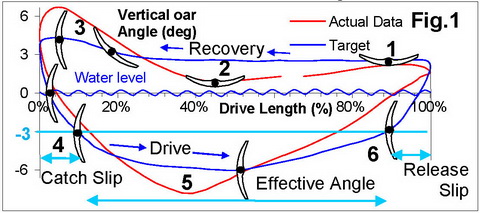Interpretation of the blade work profile

After force curve, the blade work profile is another important area of evaluation of rowing skill. Definitions of the blade work curve were given in RBN 2009/10 and 2015/08, and here we will give more insight about its interpretation.
Similar to the force curve evaluation (RBN 2018/03), the measured blade work is compared with the target curve (Fig.1, in blue), which was derived based on data from the world’s best rowers. These curves can be interpreted as the trajectory of the blade centre relative to the water: the X axis represents stroke length (horizontal oar angle), and the Y axis represents the vertical oar angle in degrees, where zero is the position of the blade’s centre at water level, i.e., the blade if half-submerged. The blade is fully submerged at a -3o vertical oar angle, so it was chosen as the criterion for catch and release slips.

During the recovery, the vertical angle is positive, which means the blade centre is above water level (1). Ideally, the feathered blade should move horizontally at about +3o, and lower vertical angles (2) mean the blade may hit the water -this creates speed losses, especially in rough weather.
Before the catch, the blade usually rises up to 4-5o to create room for squaring and still keeping the lower edge above water level. Vertical angles higher than +5o mean “skying” the blade before the catch (3) – excessive rising of the blade (= moving the handle too low), usually doesn’t allow the rower to perform a quick and effective catch.
After the catch, the blade must be quickly submerged into the water, so Catch Slip CS (4) indicates the horizontal oar travel from the catch (where it changes direction) to the point where it is fully submerged (where the vertical oar angle became less then -3o). The targets for CS are 6o in sculling and 9o in rowing.
A quick blade entry must coincide with rapid horizontal oar acceleration. This is one of the most difficult skills to learn in rowing, a type of “rowing art”. If it is performed well, the blade quickly achieves the boat speed and enters the water as if it was still and not running relative to the boat.

Visually, good blade work at the catch looks like V-shaped combination of front and back splashes at high rates, or no splashes at all at low rates (Fig.2,a). If the blade hits the water too early, or the horizontal oar acceleration is too slow, back splash can be seen (Fig.2,b), which is an indication of braking force and inefficiency of the blade work at the catch. Catch Slip CS could be less than the target in this case, but it should be evaluated in conjunction with other indicators. Single front splash (Fig.2,c) is not as bad, but indicates a slow blade entry, giving a longer CS, decreasing the blade’s propulsive efficiency.

Fig.3 shows blade work profiles and force curves, corresponding to visual images on Fig.2:
• Rower a has an 11o Catch Slip CS (slightly longer than the target), a good Catch Factor CF -27ms, a nice “connection” (acceleration of the body mass, connected to the acceleration of the handle) giving a good force curve.
• Rower b buries the blade too early without adequate horizontal acceleration (CS = 5o, CF = +2ms), so his force curve has a loop at the catch (RBN 2018/03), i.e., the blade creates a braking force.
• Rower c “skying” the blade, then “misses” the water at the catch: his blade entry is too slow, but his horizontal handle acceleration is quite fast (CS = 17o, CF = -45ms). He doesn’t have any braking force or loops on the curve, but his force increases quite slowly after the catch.
During the drive, the blade trajectory should be as horizontal as possible at the depth of about -6o vertical angle (Fig.1,5). Effective Angle EA indicates a part of the total drive length of the fully submerged blade (vertical oar angle below -3o), and the targets for it are 84% in sculling and 80% in rowing. A short EA and a too shallow blade submersion (above -3o) decreases blade efficiency, because the top edge appears above water level, so only a part of the blade works productively. A too deep blade submersion is less harmful, but is not helpful because it takes more time and effort, and creates a reverse movement of the oar shaft and adds additional drag resistance (RBN 2015/08).
At the end of the drive, the blade should stay in the water to maintain propulsive efficiency, and then it must be quickly extracted. The Release Slip RS (Fig.1,6) indicates horizontal oar travel from the point where the top edge appears above water level (vertical oar angle becomes above -3o) to the finish, where the oar changes direction. The target numbers for RS are 12o in sculling and 9o in rowing.



